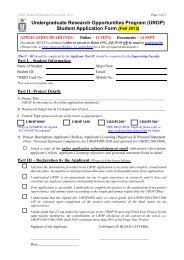UROP Proceedings 2010-11
UROP Proceedings 2010-11
UROP Proceedings 2010-11
You also want an ePaper? Increase the reach of your titles
YUMPU automatically turns print PDFs into web optimized ePapers that Google loves.
Reformation of Antimicrobial Coating – Adhesion and Durability StudyAdvisorCo-AdvisorStudent: YEUNG King Lun / CBME: LEUNG Hong Hang / CBME: WONG Ho Yee / CENG(<strong>UROP</strong>1000, Summer 20<strong>11</strong>)The objective of this project is to investigate the effect of polyethylenimine,polyvinylpyrrolidone and polyacrylamide in the adhesiveness of the encapsulated CIO 2 toglass slides. Polyethylenimine and polyvinylpyrrolidone are mixed with encapsulated CIO 2 indifferent ratios separately. The mixture with polyethylenimine and encapsulated COI 2 gives acolor of blue. After let dry for hours, the coating of mixture stays in a paste of gel and cannotdry completely. Glass slides coated with the mixture of polyvinylpyrrolidone andencapsulated CIO 2 can dry within 30 minutes. This shows that polyvinylpyrrolidone can beused to improve the encapsulated COI 2 for a better adhesiveness to glass slides.Smart Antimicrobial Coating for Porous MediaAdvisorCo-AdvisorStudent: YEUNG King Lun / CBME: LEUNG Hong Hang / CBME: YIP Shuk Ching / CEEV(<strong>UROP</strong>1000, Summer 20<strong>11</strong>)The aim of this project is to assess the persistency and durability of smart antimicrobialcoating. The coating is applied to seven types of fabric and tested for its ability to interveneagainst three types of bacteria (MRSA, S.aureus and E.coli) and mold (Cladosporium). Theresults show that seven coated fabrics have prolonged bactericidal effect over a period of 28days. Also, iodometric titration is carried out to evaluate the chlorine dioxide remaining in thecoated fabrics. The results indicate that chlorine dioxide remains after the coated fabrics aredried for 28 days.Dye-sensitized Solar CellAdvisorCo-AdvisorStudent: YEUNG King Lun / CBME: HAN Wei / CBME: ZHANG Xinyuan / CENG(<strong>UROP</strong>1000, Summer 20<strong>11</strong>)Different phases of titanium oxide are incorporated to make dye-sensitized solar cell (DSSC).The titanium dioxide layer is prepared by doctor blade technique with Degussa p-25, Aldrichanatase, rutile made from thermal treatment method and nanotubes from p-25 prepared at180°C for 30 minutes and 90 minutes, and at 195°C for 90 minutes. Standard dyeC 58 H 86 N 8 O 8 RuS 2 (N719) is used. Performance and light to electricity conversion rates arecompared among dye-sensitized solar cells prepared by different phases of titanium dioxide.31



